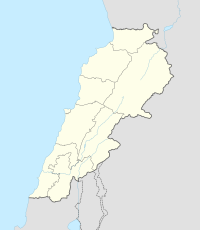| Alternative name | Deir Mar Maroun |
|---|---|
| Location | Beqaa Valley, Lebanon |
| Coordinates | 34°21′00″N 36°22′00″E / 34.35°N 36.366667°E |
| History | |
| Periods | Ancient Rome, Byzantine Empire, Mamluk, Ottoman empire |
| Site notes | |
| Condition | recently cleaned, falling into disrepair |
| Public access | Yes |
| Part of a series on the |
| Maronite Church |
|---|
 |
| Patriarchate |
| Religious orders and societies |
| Communities |
| Languages |
| History |
| Related politics |
|
|
The Monastery of Saint Maron (Syriac: Deir Mar Maroun), also called the Cave of the Monks, is an ancient cavern initially developed as a refuge structure by the Romans and later used as a Maronite monastery and carved out of solid rock in the side of a cliff. It is located around 200 metres (660 ft) from Ain ez Zarqa, the source of the Orontes river, south of Hermel in Baalbek-Hermel Governorate, northern Lebanon.[1][2][3]
YouTube Encyclopedic
-
1/3Views:3753 5891 290
-
The Church Universal - 2020-04-19 - The Eparchy of Saint Maroun in Australia
-
Eparchy of St. Maron of Brooklyn
-
Vie de St Maroun, ou Maron, moine au Liban, père de l'Église maronite (✝ 410)
Transcription
History
The cavern is situated 90 metres (300 ft) above the river. It consists of three levels with rock stairways, numerous altars, and small cells, suggested to have been the residence of Saint Maron and his early followers in the fourth century CE, during the foundation of the Maronite Church. It is suggested that Maron worked and even died in the monastery. Later occupation in Mamluk and Ottoman empire periods is attested by loopholes cut into the walls.[2][4] The monastery is commonly thought to have been constructed by Romans, however the date, builders and origins of the structure are not certain.[1]
The structure has fallen into disrepair, having been used as shelter for sheep, goats, and the occasional shepherd over the years.[5] The cavern is located on land owned by the Ministry of Energy and Water of Lebanon, but has been the subject of an ongoing dispute between the Maronite Archdiocese and the Dandash family, who stake an old claim on the land. The Maronite Archdiocese has retained rights to renovate the landmark and has stated intentions to begin a restoration project. The site has only reported to have been cleaned and no work has started on the monument, suggested to be of "national" importance.[1]
It is noteworthy to pinpoint that historians Della Volpe and D'Ambrosio think that the structure built by the Romans in the second century was not a refuge but a defense fortification of the fertile Beqaa valley (colonised by Roman veterans in Pagus Augusti and in Heliopolis) against the Persian attacks from the north.
This amazing three-level cave/monastery is cut into sheer rock that is more than 90 meters high. The site is made up of an altar, staircase and small cells carved from the rock. According to some historians, Roman engineers were the first to inhabit the site in the second century, staying in an opening they carved into rocks while they worked to irrigate the surrounding areas.In the fourth century, Saint Maron, a Syriac monk, is said to have inhabited the cave.L.T.[6]
It is suggested that Maron worked there (with many disciples, including: James of Cyrrhus, Limnaeus, Domnina, Cyra, Marana, Abraham the Hermit) and even died in the monastery.
Even if greatly damaged during Arab conquest of the region, later occupation in Mamluk and Ottoman empire periods is attested by loopholes cut into the walls.[2][7] The monastery is commonly thought to have been constructed by Romans, however the date, builders and origins of the structure are not certain.[1]
The structure has fallen into disrepair, having been used as shelter for sheep, goats, and the occasional shepherd over the years.[8]
Restoration
The cavern is located on land owned by the Ministry of Energy and Water of Lebanon, but has been the subject of an ongoing dispute between the Maronite Archdiocese and the Dandash family, who stakes an old claim on the land. The Maronite Archdiocese has retained rights to renovate the landmark and has stated intentions to begin a restoration project.
The site has only reported to have been cleaned and no work has started on the monument, even if suggested to be of national importance.[1]
See also
References
- ^ a b c d e al-Fakih, Rakan., Mar Maroun monastery restoration undeterred, The Daily Star (Lebanon, 2012-01-11. (Archived October 14, 2012, at WebCite)
- ^ a b c Michel M. Alouf; Tedd St Rain (1999). History of Baalbek. Book Tree. pp. 49–. ISBN 978-1-58509-063-1. Retrieved 15 October 2012.
- ^ Paul Doyle (1 March 2012). Lebanon. Bradt Travel Guides. pp. 215–. ISBN 978-1-84162-370-2. Retrieved 15 October 2012.
- ^ Robert Boulanger (1955). Lebanon. Hachette. Retrieved 15 October 2012.
- ^ Charles William Meredith van de Velde; Carel Willem Meredith Velde (van de) (1854). Narrative of a journey through Syria and Palestine in 1851 and 1852. W. Blackwood and sons. pp. 472–. Retrieved 15 October 2012.
- ^ Monastery/Cavern initially built by Romans
- ^ Robert Boulanger (1955). Lebanon. Hachette. Retrieved 15 October 2012.
- ^ Charles William Meredith van de Velde; Carel Willem Meredith Velde (van de) (1854). Narrative of a journey through Syria and Palestine in 1851 and 1852. W. Blackwood and sons. pp. 472–. Retrieved 15 October 2012.
External links
- Deir Mar Maroun on satelliteviews.net
- Caves of "Raheb" on discoverlebanon.com
- Deir Mar Maroun on the Megalithic Portal
- Deir Mar Maroun on ikamalebanon.com
- Deir Mar Maroun Dispute - LBC News on YouTube
- Deir Mar Maroun on middleeast.com
- 3D Google Map of Deir Mar Maroun on gmap3d.com
- Deir Mar Maroun photo
- Deir Mar Maroun photo


